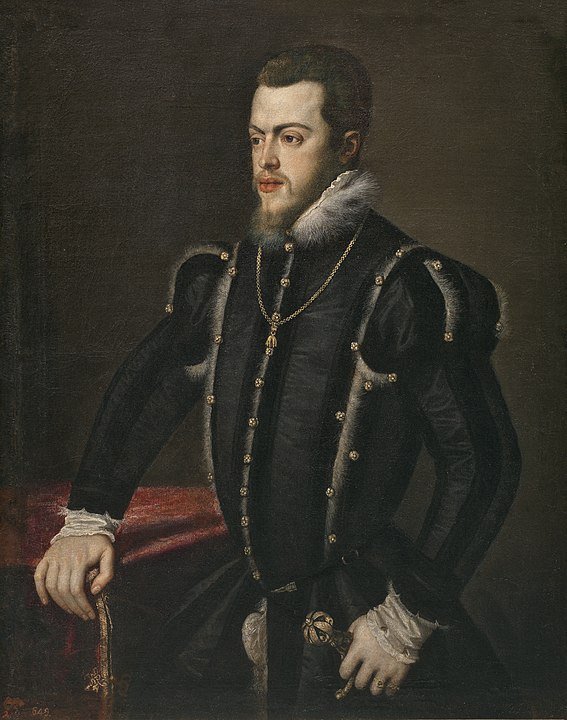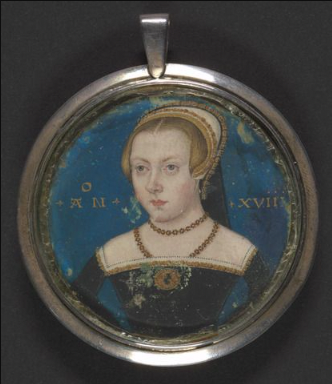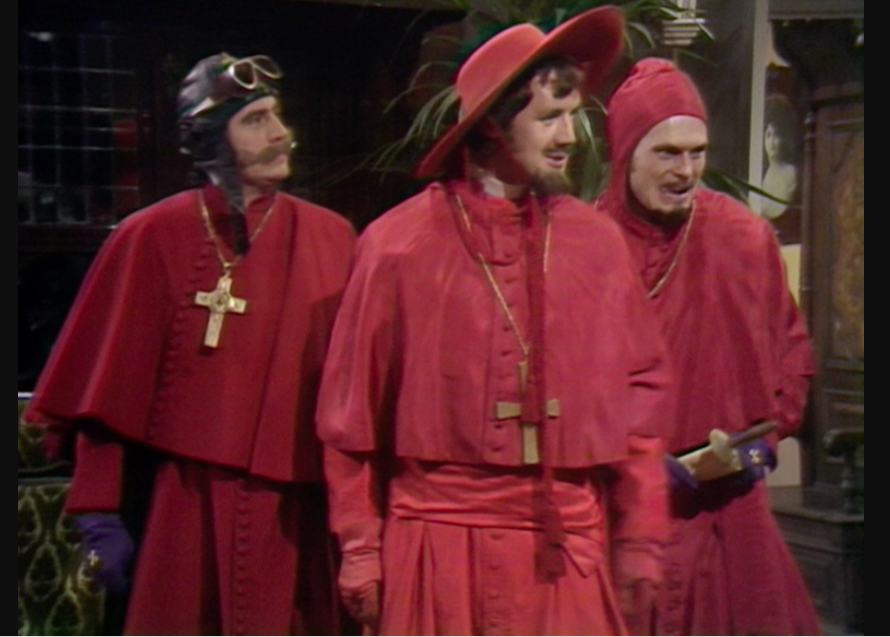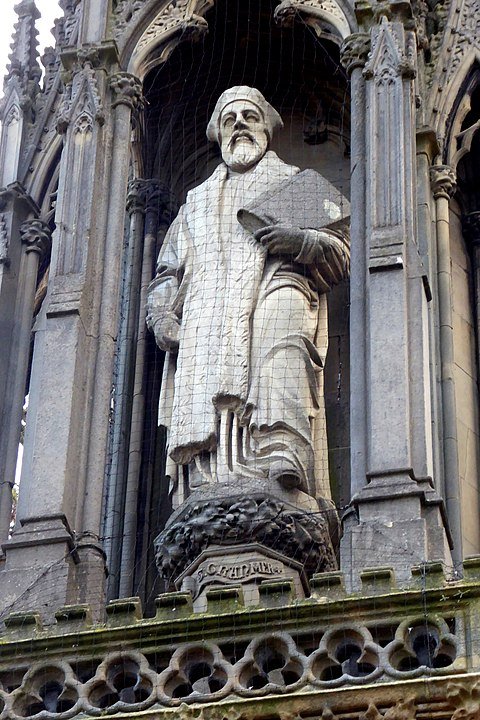Bloody Mary Tudor?
313 people were killed for their beliefs in England and Wales between 1555 and 1558, during the reign of the Roman Catholic Queen Mary Tudor. Most of them were burned at the stake.
But like almost all episodes in England’s Catholic history, modern scholarship shows that this one’s been badly misunderstood. We’ve been investigating it, not in any way in order to excuse what happened, but to try to understand it. We feel we owe it to the victims to get the story straight.
‘Blood on her memory – the legacy of England's first and only Catholic queen’
Mary I has become “Bloody Mary”, only remembered for burning Protestants at the stake. But is there more to her than this?
Bloody Queen Mary? 313 people died for their beliefs 1555-58. We owe it to the victims to get the story right. In 2020 historian Alexander Samson said about the reign of Mary Tudor ‘it feels as if we are at the start.’ So dismiss everything you thought you knew and be prepared to be amazed. Ever since Mary died childless, at the age of just 42 in 1558, the history of her reign was written almost exclusively by English Protestant historians, mainly using Foxe’s ‘Book of Martyrs’ written by an Elizabethan Protestant. We look at why Foxe exclusively blames Mary and why he’s wrong.
England in the mid-1550s was being governed by a joint monarchy: Philip and Mary and a select council of extremely able English politicians. Almost all of them had experience in government stretching back through the violently protestant regime of Edward VI. To all appearances they had for years been living as active protestants. And yet here they were in a government that was conducting a campaign against religious heresy that we have always understood to be a Catholic campaign to stamp out Protestantism.
Who ran the persecution of heretics in England 1555-58? England was a joint monarchy but historians traditionally accused bigoted Mary of running the clamp down herself - with her cousin, Reginald Pole the Archbishop of Canterbury. There’s no evidence it’s true and Pole was useless at running anything. But didn’t Mary intervene to make sure Thomas Cranmer was burned – Henry VIII’s archbishop? No, again. Cranmer was tried by the pope and Mary had no power to spare him. As for Mary’s Privy Council, they turn out to have been more interested in pirates than heretics. Much more important was Bartolomé Carranza, a Spanish friar, King Philip’s trusted eyes and ears at the English Court, but he was later accused of heresy by the pope for being too lenient. Finally the campaign in England was distinctively English, not Spanish. That points the finger for responsibility at Philip’s own select council of veteran English courtiers. But almost all of them had for years been Protestants. What was going on?
Until six weeks before the child was due, everybody at court and indeed in Europe, believed Mary was pregnant. She suffered a rare disorder - pseudocyesis - maybe triggered by a tumour on her pituitary gland that would eventually kill her. The imminent birth of a Catholic heir to the Anglo-Spanish dynasty meant that the select council governing the kingdom really now had no alternative but to grasp the nettle of suppressing any potential causes of unrest – including any remaining shreds of die-hard Protestantism - and promptly. We also discover, that the majority of those who were burned were not Protestants at all, but followers of much older, rural religions.
Most of those executed for their beliefs under Philip and Mary 1555-58 came from places with a long history of religious dissidence. It matches European evidence that many – perhaps most – of those burned at the stake were not Protestants, but ‘anabaptists’ or people with similar beliefs – usually poor - whom both Protestants and Catholics were persecuting. The government of Edward VI had already begun before Mary came to the throne. But why so many in England? We discover literature appearing from the late 1540s that openly encouraged dissenters to die for their beliefs. And we explore the possibility that so many died because the English uniquely insisted on public hearings, in which there was no room for quiet, face-saving compromises.


















There are now a number of important books completely reinterpreting the period we now need to call the reign of Philip and Mary. Start with Alexander Samson, Mary and Philip. The Marriage of Tudor England and Habsburg Spain (Manchester University Press 2020) which gives you a good sense of the complete revolution in Marian studies. Then read John Edwards, Mary I. England’s Catholic Queen (Yale University Press 2011). Edwards is an Hispanicist and brings much needed Spanish perspective. This is his best book so far. Next look at the essays in Susan Doran and Thomas S. Freeman (eds), Mary Tudor: old and new perspectives (Palgrave Macmillan 2011), especially the chapters by Freeman and Wizeman. Finally pick up a couple of papers - Glyn Redworth, ‘“Matters Impertinent to Women”: Male and Female Monarchy under Philip and Mary’, English Historical Review 112 (1997), pp. 597-613; and a consideration of Mary and her confidants, Anna Whitelock, ‘A Woman in a Man's World: Mary I and political intimacy, 1553–1558’, Women’s History Review 16 (2007), pp. 323-334.
We’re waiting with real excitement for Gonzalo Velasco Berenguer‘s work to come out in print - Habsburg England: Politics and Religion in the Reign of Philip I (1554-1558), to be published by Brill in 2022 and 'The Select Council of Philip I: A Spanish Institution in Tudor England (1555-1558)', to be published by English Historical Review, also in 2022. Velasco argues that the rule of Philip and Mary was a joint monarchy, based on the model of Isabella and Ferdinand in turn of the century Spain. We’ve argued that, in Tudor England, Mary would have found it more difficult to be heard. But Velasco has done the most up-to-date work on Philip in England and his work will change the whole landscape (yet again.) We’ve been very grateful to be able to discuss this whole field with Gonzalo as we’ve gone along. As academics always say, however, our mistakes are all our own.
Look up Mary’s possible long-term illness in Milo Keynes, ‘The aching head and increasing blindness of Queen Mary I,’ in Journal of Medical Biography 8 (2000), pp. 102-109. Check out pseudocyesis – the medical condition of ‘phantom pregnancy’ – for example in Gary W. DeVane ‘Pseudocyesis’, Seminars in Reproductive Medicine 8 (1990), pp. 74-80.
You could also read Dale Hoak’s seminal piece on the Marian council, ‘Two revolutions in Tudor Government: the Formation and Organisation of Mary I’s Privy Council’, in D. Coleman and D. Starkey (ed.), Revolution Reassessed. Revisions in the History of Tudor Government and Administration (Oxford University Press 1986), pp. 87-115. It bears saying, sadly, that we now need to treat anything from the ubiquitous output of David Loades with extreme scepticism. It all now looks far too coloured by Foxean Protestantism and traditional constitutionalism to stand up any longer alongside the complete rewriting of this period.
Mary’s religious policy is in particular still waiting for its own thorough-going, up-to-date synthesis. Eamon Duffy and David Loades, (eds.), The Church of Mary Tudor (Abingdon and NY 2006) is a mixed bag, with David Loades’s introduction on Mary’s religion much as you’d expect. John Edwards, ‘Spanish Religious Influence in Marian England’ and Patrick Collinson’s oddly old-fashioned chapter on Kent are the most useful essays. Eamon Duffy’s Fires of Faith. Catholic England under Mary Tudor (Yale 2009) is a self-consciously revisionist book that brings a lot of detail to the table. But Duffy goes along with much of Foxe’s old interpretation, that the whole thing was mainly Mary’s fault, pushed along by a few fanatics. He even blames Mary for Cranmer’s execution, which is contradicted in John Edwards’ biography of Mary I (above). Peter Marshall’s Heretics and Believers (Yale 2017) promises much and has plenty of information, but also adopts a surprisingly traditional, not to say Protestant, approach to the Marian persecution.
We argue in the series that we need to understand at least the basics of the legal framework for the campaign against heresy, which made it different from other campaigns in Europe. Here you need PR Cavill’s revealing and little-cited work on the heresy laws and other legal issues at ‘Heresy and Forfeiture in Marian England’, The Historical Journal, 56 (2013), pp. 879–907 and ‘Heresy, Law and the State: Forfeiture in Late Medieval and Early Modern England’, English Historical Review 129 (2014), pp. 270-95.
John Foxe’s Acts and Monuments (4 editions, 1563-83) is so detailed and compellingly passionate that it is no surprise that historians for generations looked no further. You can get the whole enormous text, in all its editions, in searchable, online format here, product of the British Academy John Foxe Project – a fine piece pf work but in itself a symbol of the dire shadow that Foxe for so long cast over the study of Philip and Mary. Beware: Foxe’s point of view is extremely beguiling but just as misleading. We now know that he suppressed many details and made many others up.
It’s also important to understand the English religious background. For the fifteenth century look no further than Brad G. Gregory, ‘Reforming the Reformation: God’s truth and the exercise of power’ in Tom Mayer (ed.), Reforming Reformation (Abingdon and NY 2012, 2016). For a striking contrast to the 1550s, see the treatment of heretics under Henry in Craig d’Alton, ‘The Suppression of Lutheran Heretics in England 1526-1529’, Journal of Ecclesiastical History 54, (April 2003), pp. 228-53.
For more on religious change under Henry and Edward try Alec Ryrie, The Age of Reformation (London 2nd ed. 2017). Ryrie takes a revisionist view of the Hertford ‘coup’ of January 1547 we talk about in the series. See also Robert Lutton and Elisabeth Salter (eds.), Pieties in Transition. Religious Practices and Experiences, c. 1400-1640 (2007, 2016 Abingdon and New York) for Andrew Hope’s essay on the Henrician and Edwardian martyrs. For the Edwardian period you really should read Ronald Hutton’s now classic 1987 ‘The local impact of the Tudor reformations’, reprinted in Peter Marshall (ed.), The Impact of the English Reformation 1500-1640, (1997), pp. 142-66.
The European context is missing from all the older (and even most recent) English accounts. But it is crucial. The best short introduction to the European Reformation for non-specialists we’ve come across is in Brent F Nelson and James L Guth, Religion and the Struggle for European Union: Confessional Culture and the Limits of Integration (Georgetown University Press 2015). You’ll also want to read Anne Overell’s fascinating insights into a range of issues from the Spirituali to anti-Nicodemite literature, in her Italian Reform and English Reformations, c.1535–c.1585 (Abingdon and NY 2008). See also her essay in Tom Mayer (ed.), Reforming Reformation (Abingdon and NY 2012, 2016).
John W O’Malley, Trent: what happened at the Council (Harvard 2013) is, as its title suggests, an easy introduction to the Council of Trent. For a clear account of Regensburg go to Anthony LS Lane, Regensburg Article 5 on Justification. Inconsistent Patchwork or Substance of True Doctrine? (Oxford University Press 2020). For an excellent introduction to the Peace of Augsburg see Violet Soen, ‘From the Interim of Augsburg until the Treaty of Augsburg (1548-1555)’, in A. Melloni (ed.), Martin Luther. A Christian between Reforms and Modernity (1517-2017), (Berlin, De Gruyter, 2017) vol. 1, pp. 548-564.
For the depressing details on the infighting in Rome that preceded the election of successive popes, go to John Paul Adams’s comprehensive online resource here and other pages on the same site. For an excellent essay on ‘confessionalisation’ – a term we do not use, and a controversy we don’t get into in our podcast, but which broadly means the enforcement of religious unity by the state – see Peter Marshall, ‘Confessionalisation, Confessionalism and Confusion in the English Reformation’, in Tom Mayer (ed.), Reforming Reformation (Abingdon and NY 2012, 2016).
You can’t avoid getting to grips with the various Inquisitions. Go to Ole Peter Grell and Bob Scribner (eds.), Tolerance and intolerance in the European Reformation (Cambridge 1996), because you will want to read William Monter’s seminal essay on heresy executions. Here is also a good essay by Diarmaid MacCulloch on Cranmer – which is much shorter than his immense biography of the man. You learn much more about the European Inquisitions from Donal Prudlo (ed.) A Companion to Heresy Inquisitions (Brill 2009). Despite the weirdly uncomfortable title, the book has excellent essays by Werner Thomas on the Spanish Inquisition, Elena Bonora on the Roman Inquisition and Fedrico Berbieto on the Venetian Inquisition. Add to those the essays in Ronald K. Delph, Michelle M. Fontaine and John Jeffries Martin (eds.), Heresy, Culture, and Religion in Early Modern Italy (Penn State University 2007), especially John Jeffries Martin’s introduction and the essay by Silvana Menchi on the way Inquisitors tried to find compromises. But don’t miss Jane K. Wickersham, Rituals of Persecution: the Roman Inquisition and the Prosecution of Philo-Protestants in Sixteenth-Century Italy (University of Toronto Press 2012) and especially Chapter 4 on the discretion the court had over executions. It is essential for understanding what happened to Cranmer.
If you want more detail on the way the Spanish Inquisition worked, you still have to refer to Henry Charles Lea’s antique A History of the Inquisition in Spain (1907, 2017). But see also Maureen Flynn, ‘Mimesis of the Last Judgment: The Spanish Auto de fe’, in The Sixteenth Century Journal, 22 (1991), pp. 281-297. For a balancing view on the Spanish see Henry Kamen’s classic paper, ‘Toleration and Dissent in Sixteenth-Century Spain: The Alternative Tradition’, The Sixteenth Century Journal, Spring, 1988, Vol. 19, No. 1 (Spring, 1988), pp. 3-23.
For the Spanish religious influence in England see Elizabeth Evenden’s essay, ‘Spanish Involvement in the restoration of Catholicism during the Reign of Philip and Mary’, in Elizabeth Evenden and Vivienne Westbrook, Catholic Renewal and Protestant Resistance in Marian England (Abingdon and NY 2015, 2016). Other chapters in the book are interesting too, if not central to the argument we’ve been putting forward. Anne Dillon’s investigation into the possible influence of Álvarez on Philip in early 1555 is in the intriguingly entitled (and fun to read) Michelangelo and the English Martyrs (London and NY 2016). Also essential here, if not easy to follow is J Edwards, ‘A Spanish Inquisition? The Repression of Protestantism under Mary Tudor’, Reformation and Renaissance Review, 4 (2000), pp. 62-74.
The essential book on Bartolomé Carranza – who is clearly key to this story - is John Edwards and Ronald Truman (eds.), Reforming Catholicism in the England of Mary Tudor. The achievement of Friar Bartolomé Carranza (London and NY 2005, 2017). Read at least the introduction by José Ignacio Tellechea Idígora. See also John Edwards, ‘Fray Bartolomé Carranza’s Blueprint for a Reformed Catholic Church in England’ in Thomas F. Mayer (ed.), Reforming Reformation, (Farnham, Ashgate, 2012), pp. 141–62.
You may want to pursue some of the other people we talk about. For Thomas Cranmer you will not be able to go beyond Diarmaid MacCulloch’s vast Thomas Cranmer. A Life (New Haven and London 1996). Immense and scholarly, it is now, inevitably, looking just a little dated when it comes to the reign of Philip and Mary.
But it is just about the only decent biography of the central characters in this story. You’ll find an account of the making of Stephen Gardiner’s reputation in Michael Riordan, Alec Ryrie, ‘Stephen Gardiner and the Making of a Protestant Villain’, Sixteenth Century Journal 34 (2003), pp. 1039-63. But where is the full-dress biography of this key individual?
For Reginald Pole there is John Edwards, Archbishop Pole (London and NY 2014), which is more helpful than Thomas F. Mayer, Reginald Pole: Prince and Prophet (Cambridge 2000). Mayer’s multi-volume edition of Pole’s correspondence (London and NY, 2004-17) is, of course, an essential source. But it is exceedingly frustrating, mostly just Mayer’s jottings, which read like undergraduate notes and raise as many questions as they answer.
For Edmund Bonner read Gina Alexander, ‘Bonner and the Marian persecutions’, History 60 (1975), pp. 374-391. It’s dated but still good, and read alongside everything else on this list you get the idea. Anyway, Gina Alexander was then a teacher at a state comprehensive – so we should celebrate her having the time and courage to get an academic paper published. It was reprinted in Christopher Haigh (ed.), The English Reformation Revised (Cambridge University Press 1987).
For Paulet there is Margaret Scard, Tudor Survivor. The Life and Times of William Paulet (History Press, Stroud 2011). For Paget the best we have is Barrett L. Beer and Sybil M. Jack, The Letters of William, Lord Paget of Beaudesert 1547-1563 (Camden Society 1974). Why there is still no decent biography of this key mid-Tudor figure is a mystery. Otherwise, for Paget and Petre it looks as though the best you can do is ADK Hawkyard and DF Coros’s long biographical articles in ST Bindoff (ed.), The History of Parliament: the House of Commons 1509-1558 (Boydell and Brewer 1982) and now online here.
You’ll understand from our series that the local history of religious dissent is a key, and oddly still neglected context. So far the best compendium of the available detail on the martyrs is Thomas Freeman’s list here. It’s an essential reference.
For Kent see Robert Lutton, ‘Geographies and Materialities of Piety. Reconciling Competing Narratives of Religious Change in Pre-Reformation and Reformation England’ and also Andrew Hope, ‘Martyrs of the Marsh, Elizabeth Barton, Joan Bocher and trajectories of martyrdom in Reformation Kent’, both in Robert Lutton and Elisabeth Salter (eds.), Pieties in Transition. Religious Practices and Experiences, c. 1400-1640 (2007, 2016 Abingdon and New York). Patrick Collinson, ‘The Persecution in Kent’ in E. Duffy and D. Loades, The Church of Mary Tudor (Abingdon and NY 2006) is (as we’ve said) still useful. There are also a couple of contextual essays in Michael Zell, Early Modern Kent (Woodbridge 2000). Also relating to Kent, read Jeremy Goring’s very good Burn Holy Fire. Religion in Lewes since the Reformation (Cambridge 2003).
For the case of Richard Woodman, the Wealden ironmaster who was burned at Lewes, you will have to tackle Paul Quinn’s difficult to follow ‘Richard Woodman, Sussex Protestantism and the Construction of Martyrdom’ in Matthew Dimmock, Andrew Hadfield and Paul Quinn (eds.), Art, Literature and Religion in Early Modern Sussex Culture and Conflict (Abingdon and NY, 2104, 2016)
Diarmaid MacCulloch’s Suffolk and the Tudors. Politics and Religion in an English County (Oxford University Press 1986) gives excellent detail on local heresy there, written by a local boy made good. A fine account of the Mendlesham heretics is Angus Williams, ‘The Early Modern Religious History of Mendlesham’ here. Laquita Higgs traces the history of Lollardy in Colchester in Godliness and Governance in Tudor Colchester (Ann Arbor 1998).
For witchcraft in England the books are James Sharpe, Witchcraft in Early Modern England (2nd ed, Abingdon and NY 2020) and Alan Macfarlane, Witchcraft in Tudor and Stuart England. A Regional and Comparative Study (1970, 2nd ed., London 1999).
Compare William Allen, A Brief Historie of the Glorious Martyrdom of Twelve Reverend Priests (ed. JH Pollen London 1908, available online) for ghastly and rarely heard detail on the persecution of Catholics under Elizabeth. Diego de Yepes, Historia particular de la persecucion de Inglaterra, y de los martirios mas insignes que en ella ha auido, desde el año del Señor 1570 (1599) is much more comprehensive, but in 16th century Spanish. It’s also online.
Finally, read Thomas Freeman, ‘Inventing Bloody Mary’ in Doran and Freeman, Mary Tudor, to discover how the myth was created late in the seventeenth century and consolidated in the nineteenth and early twentieth.


